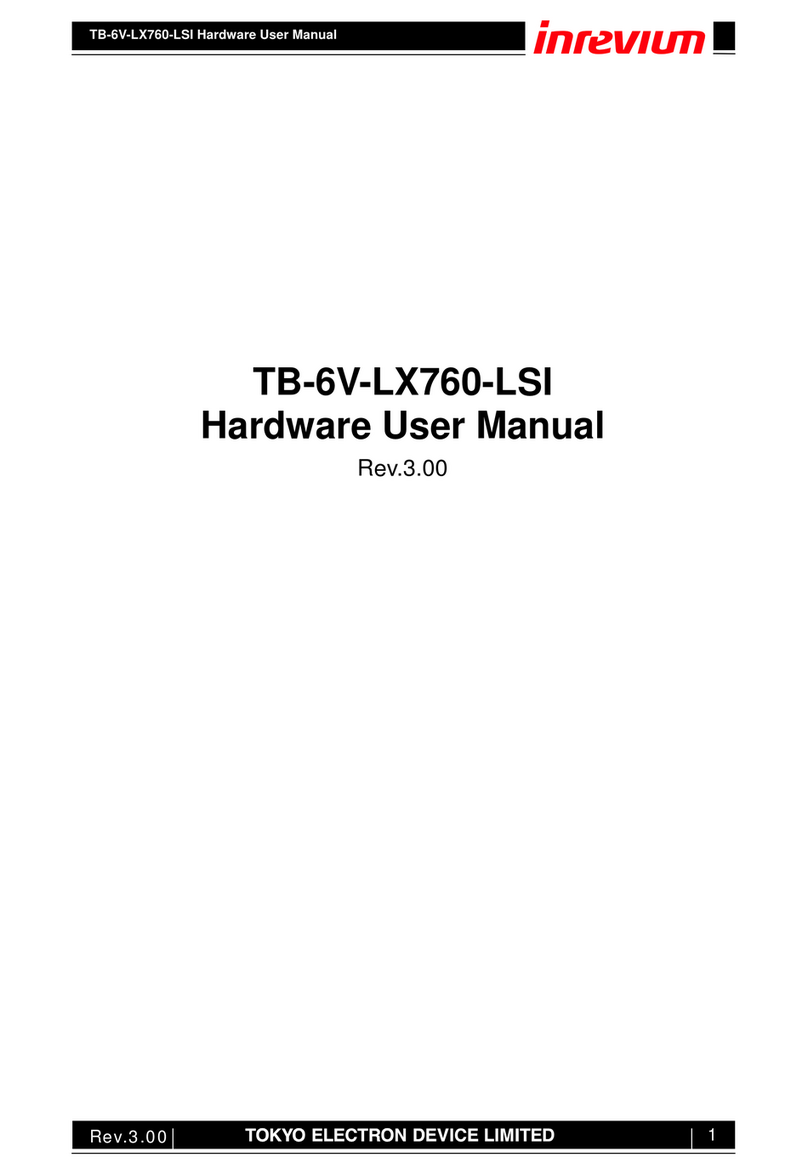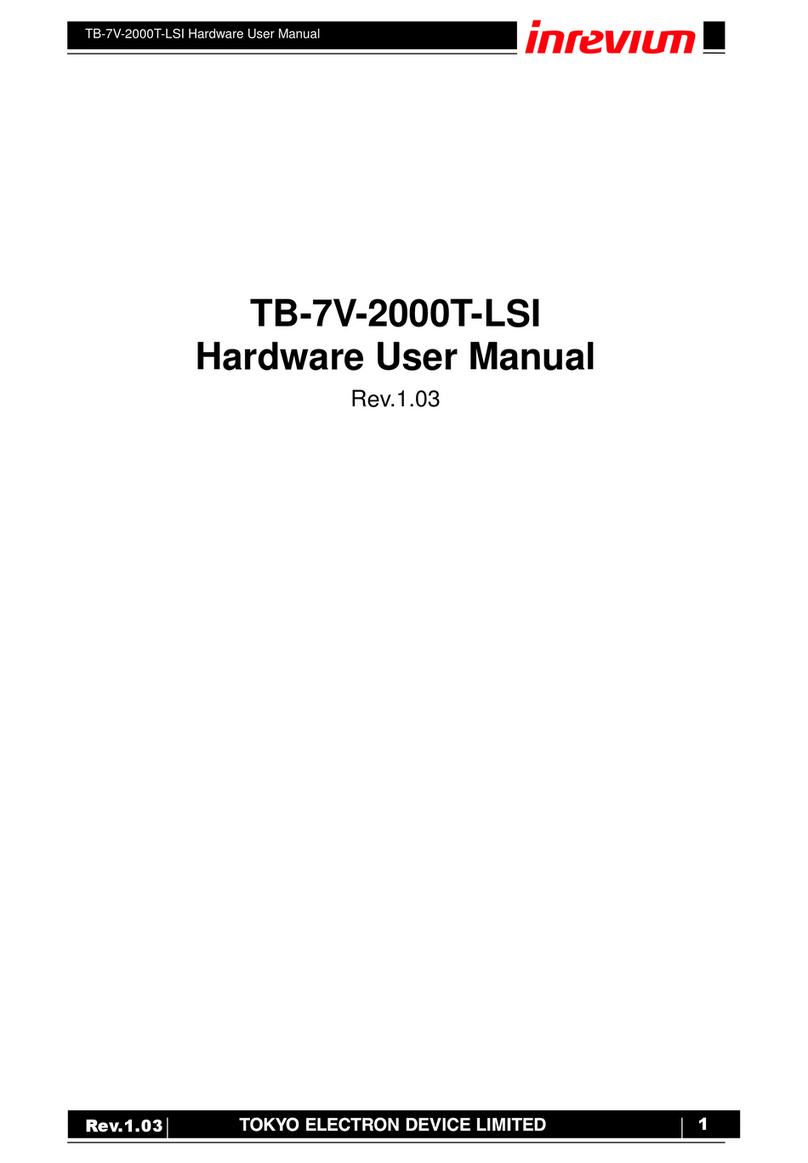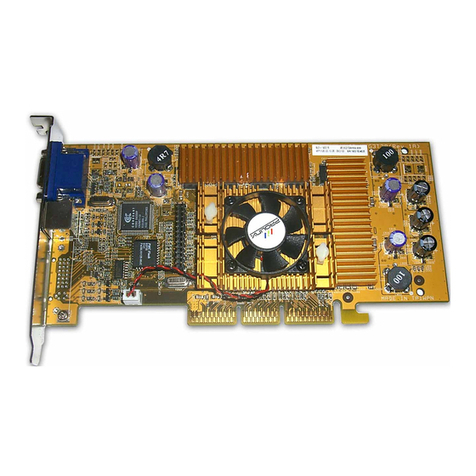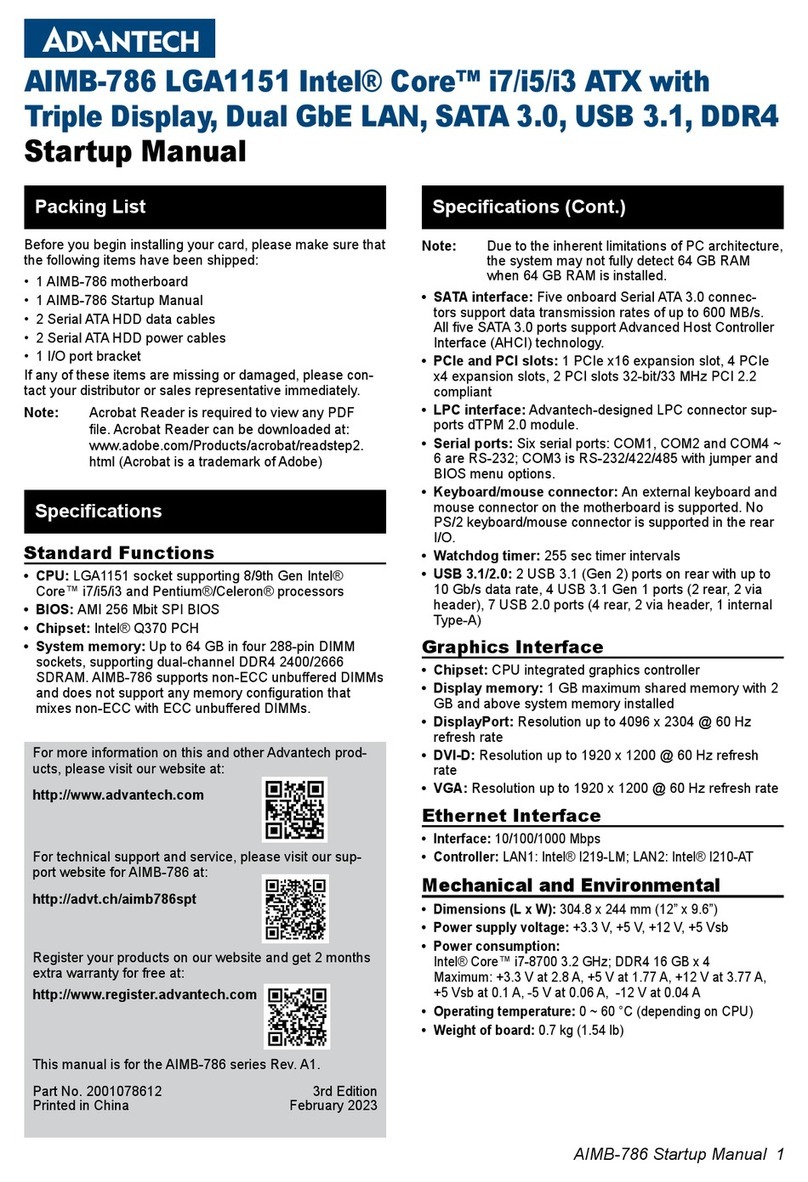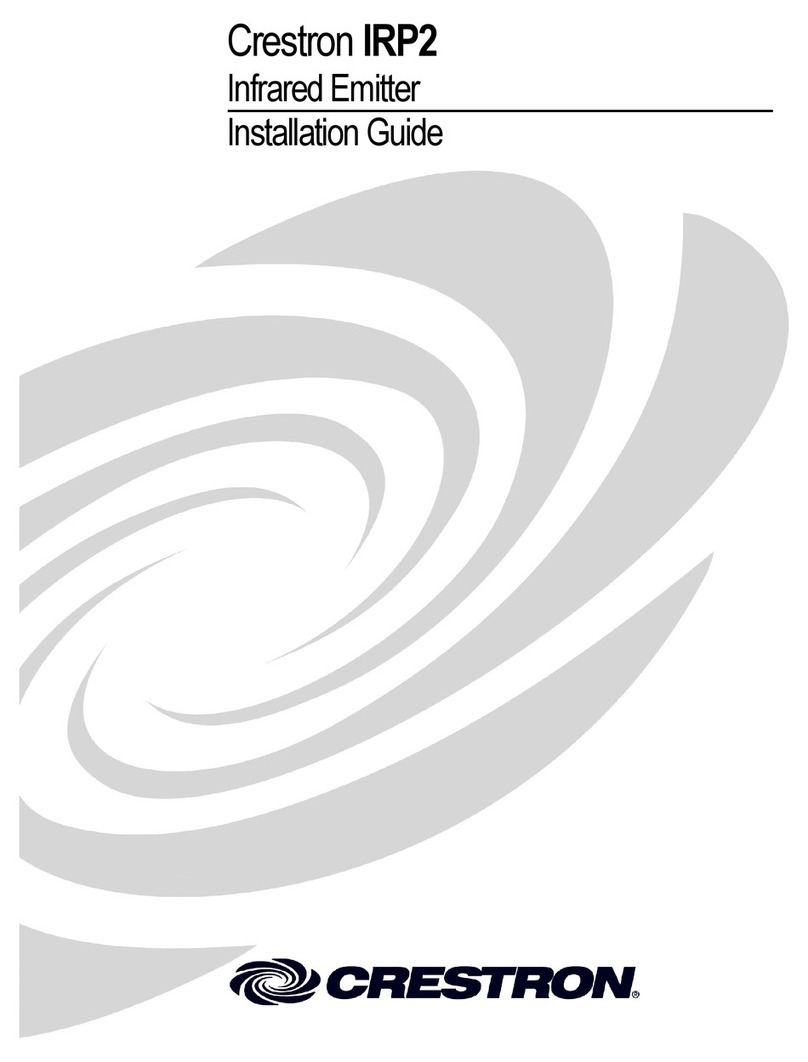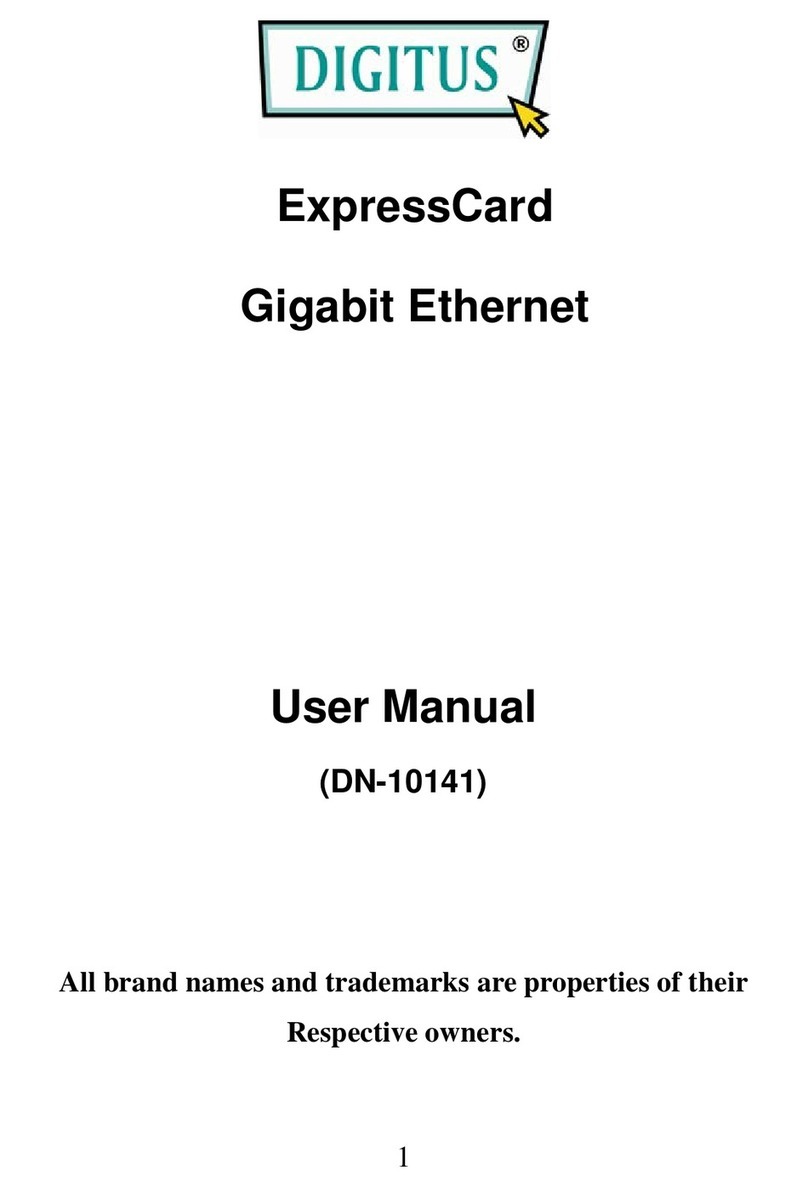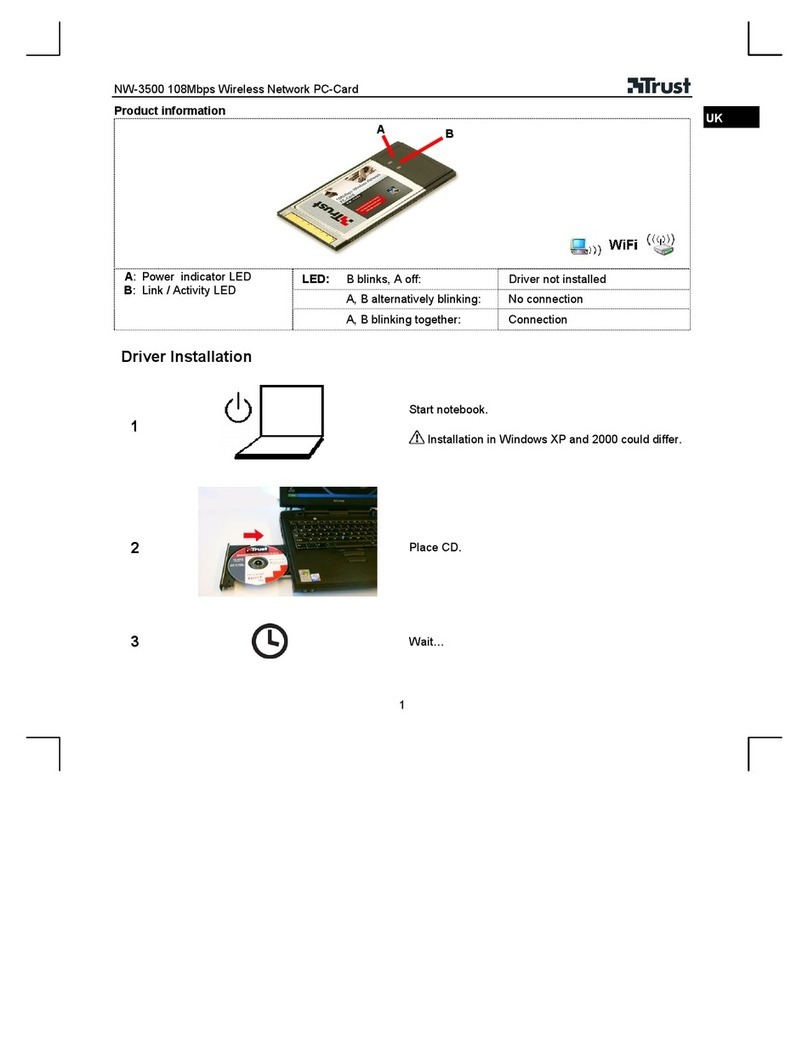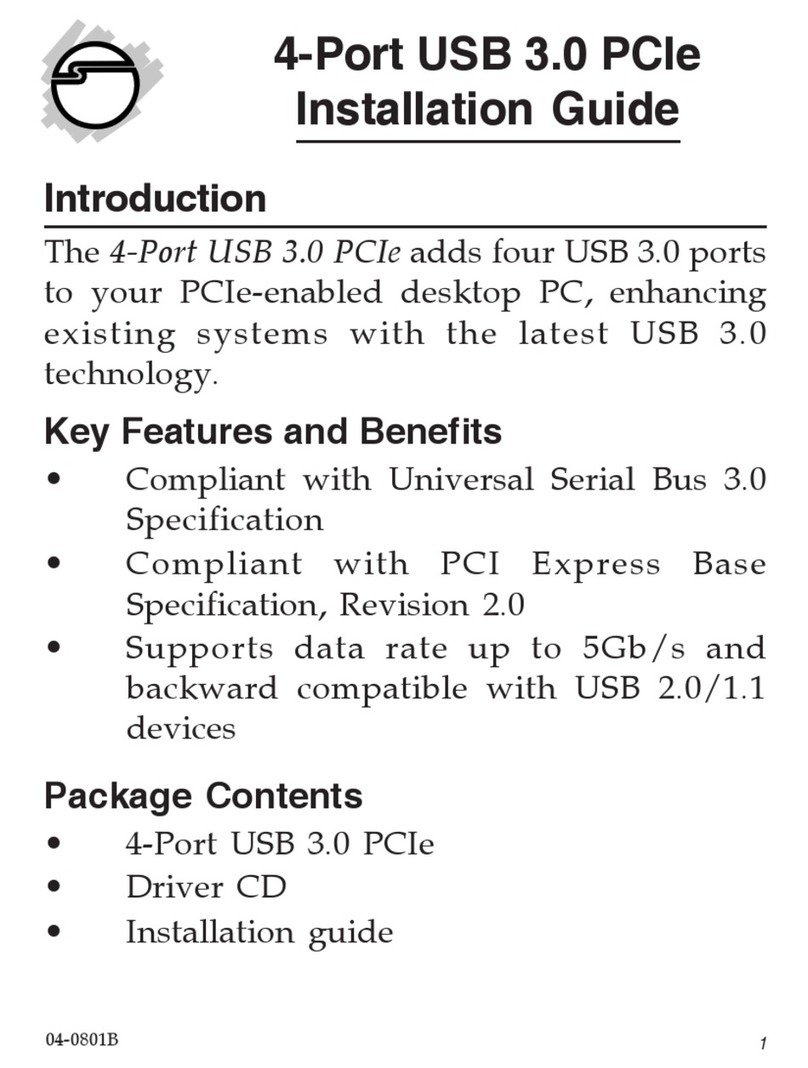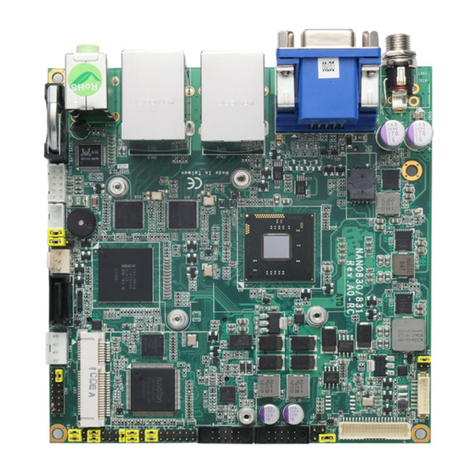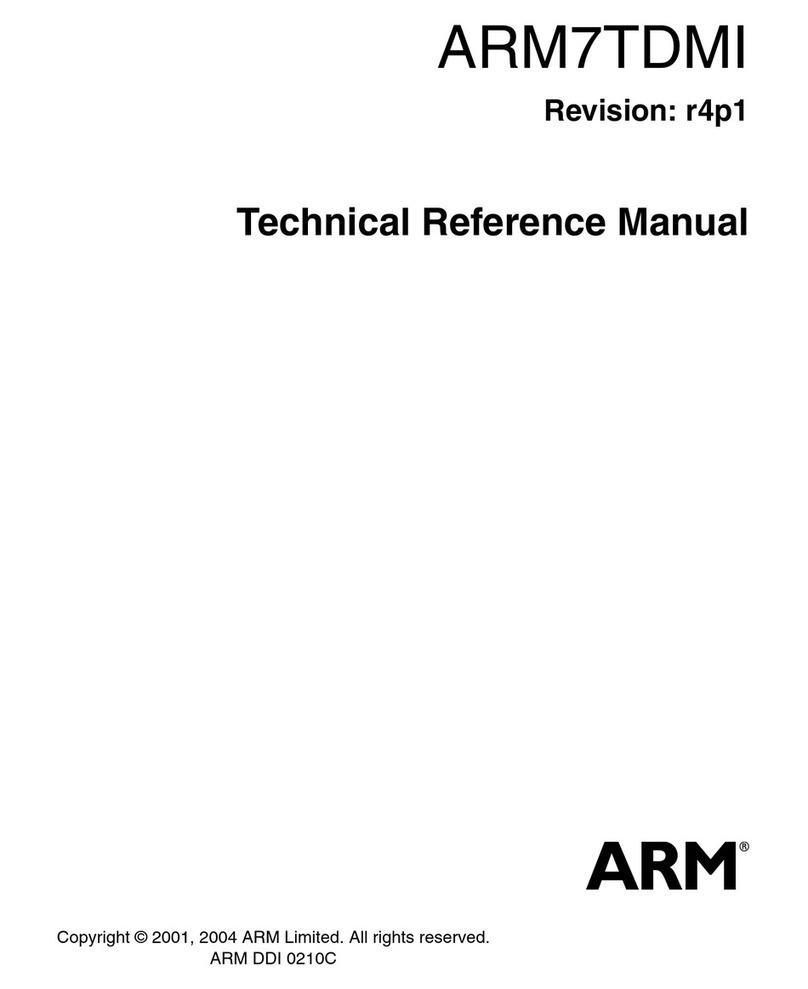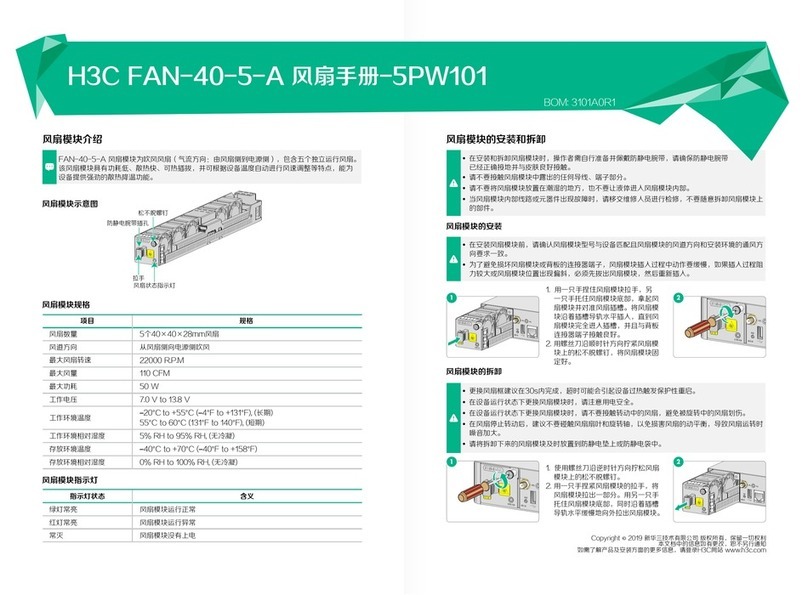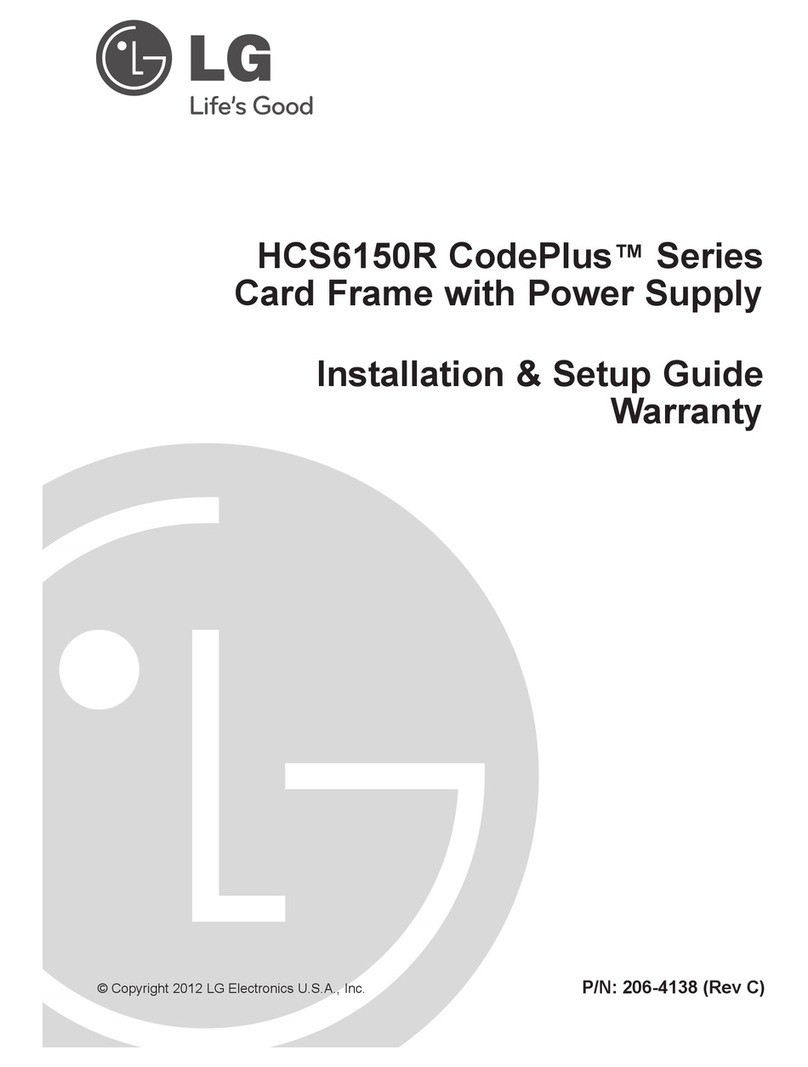Inrevium TB-7Z-IAE Instructions for use

TB-7Z-IAE Hardware User Manual
1
Rev.
1.0
5
TB-7Z-IAE
Hardware User Manual
Rev.1.05
No reproduction or republication of part or the whole of the contents of this document is strictly
prohibited.
The company name and the product name described in this document is a trademark or a
registered trademark of each company.
Tokyo Electron Device Limited assumes no responsibility or liability for any damages, including,
but not limited to, any special, incidental, or consequential damages arising out of any error in
publication or the use of this document.
The content of this document may be changed without prior notice.

TB-7Z-IAE Hardware User Manual
2
Rev.
1.0
5
Revision History:
Version Date Description Publisher
Rev.1.00 2015/04/22 Initial Version Kiguchi
Rev.1.04 2015/10/06 Update for TB-7Z-IAE Rev3
Added information : 3. Feature
Updated information : 7. Main Specification
Added information : 8. Board Specification
Added information : 10.2. Power supply structure
Updated information : 10.3. Clock structure
Added information: 10.4. Board status LED
Added information: 10.5.6. PS_POR_B_MR, PS_SRST
Added information: 10.6. Fixing screw hole
Added information: 10.8. microSD card socket (CN902)
Added information: 10.12. QSPI Flash
Added information: 10.13. F-RAM
Added information: 10.14. RTC
Kiguchi
Rev.1.05 2015/12/03 Updated information : 10.5.3. I/O voltage selection
jumper of USER_IOP/N (J101)
Added information : 10.5.9. B2B connector trace length
list
Added information : 10.5.10.Zynq, USB - B2B Connector
schematic
Added information : 10.8. Tested microSD card
Updated information : 11. Boot Mode Setting (J303/J304)
Updated information : 12. JTAG Mode Setting (J305)
Kiguchi

TB-7Z-IAE Hardware User Manual
3
Rev.
1.0
5
Table of Contents
1. Related documents:..................................................................................................................... 9
2. Overview...................................................................................................................................... 9
3. Feature ........................................................................................................................................ 9
4. Glossary of Terms...................................................................................................................... 10
5. Block Diagram............................................................................................................................11
6. External View of TB-7Z-IAE....................................................................................................... 12
7. Main Specification ..................................................................................................................... 13
8. Board Specification.................................................................................................................... 14
9. Address Map ............................................................................................................................. 14
10. Description of Components....................................................................................................... 16
10.1. Zynq...................................................................................................................................... 16
10.1.1. Heat sink (optional)........................................................................................................... 17
10.1.2. References ....................................................................................................................... 18
10.2. Power supply structure......................................................................................................... 19
10.3. Clock structure...................................................................................................................... 21
10.4. Board status LED (LED1/LED201)....................................................................................... 22
10.5. B2B connector (CN901) ....................................................................................................... 23
10.5.1. Input power source........................................................................................................... 28
10.5.2. USER_IOP00~23, USER_ION00~23............................................................................... 29
10.5.3. I/O voltage selection jumper of USER_IOP/N (J101)....................................................... 29
10.5.4. USER_GIO0~11 ............................................................................................................... 30
10.5.5. USER_MIO22, 23, 24, 25, 26, 27, 46, 47, 48, 49............................................................. 31
10.5.6. PS_POR_B_MR, PS_SRST............................................................................................. 32
10.5.7. USB_DP, USB_DM, USB_CPEN, USB_VBUS, USB_ID................................................. 33
10.5.8. +3.3VD Output.................................................................................................................. 34
10.5.9. B2B connector trace length list......................................................................................... 34
10.5.10. Zynq, USB - B2B Connector schematic........................................................................ 35
10.6. Fixing screw hole.................................................................................................................. 36
10.7. Gigabit Ethernet(CN1002)............................................................................................... 38
10.8. microSD card socket (CN902).............................................................................................. 43
10.9. JTAG connector (CN201) ..................................................................................................... 45
10.10. User LED (LED301/LED302/LED303) ................................................................................. 46
10.11. DDR3 SDRAM...................................................................................................................... 47
10.12. QSPI Flash ........................................................................................................................... 49
10.13. F-RAM .................................................................................................................................. 50
10.14. RTC ...................................................................................................................................... 52
11. Boot Mode Setting (J303/J304)................................................................................................. 54
12. JTAG Mode Setting (J305)........................................................................................................ 55
13. Default Factory Setting.............................................................................................................. 57

TB-7Z-IAE Hardware User Manual
4
Rev.
1.0
5
List of Figures
Figure 5-1TB-7Z-IAE block diagram...........................................................................................11
Figure 6-1Component side ........................................................................................................ 12
Figure 6-2 Solder side.................................................................................................................... 12
Figure 8-1Board dimensions..................................................................................................... 14
Figure 9-1System address map ................................................................................................ 15
Figure 10-1Heat sink .................................................................................................................. 17
Figure 10-2Power supply structure .......................................................................................... 19
Figure 10-3Recommended +5V supply voltage timing......................................................... 20
Figure 10-4Clock structure........................................................................................................ 21
Figure 10-5Status LEDs ............................................................................................................. 22
Figure 10-6B2B connector connecting structure.................................................................... 23
Figure 10-7B2B connector......................................................................................................... 24
Figure 10-8Power supply structure .......................................................................................... 28
Figure 10-92.5V Mode Setting ................................................................................................... 29
Figure 10-92.5V Mode Setting ................................................................................................... 29
Figure 10-10PS_POR_B_MR timing........................................................................................ 32
Figure 10-11Example of user board connection ..................................................................... 33
Figure 10-12TB-7Z-IAE fixing screw hole................................................................................. 36
Figure 10-13 Connection between a screw hole and the ground.............................................. 37
Figure 10-14RJ45 connector ..................................................................................................... 38
Figure 10-15Gigabit Ethernet peripherals................................................................................ 40
Figure 10-16microSD card socket............................................................................................. 43
Figure 10-17Method to insert/remove the microSD card........................................................ 44
Figure 10-18JTAG connector..................................................................................................... 45
Figure 10-19JTAG connector pin .............................................................................................. 45
Figure 10-20User LEDs .............................................................................................................. 46
Figure 10-21DDR3 SDRAM ........................................................................................................ 47
Figure 10-22DDR3 SDRAM connections.................................................................................. 48
Figure 10-23QSPI Flash ............................................................................................................. 49
Figure 10-24F-RAM..................................................................................................................... 50
Figure 10-25RTC......................................................................................................................... 52
Figure 10-26RTC battery connection........................................................................................ 53
Figure 11-1JTAG Boot setting ................................................................................................... 54
Figure 11-1SD Card Boot setting .............................................................................................. 54
Figure 11-1QSPI Boot setting.................................................................................................... 54
Figure 12-1 Cascade Mode Setting............................................................................................... 55
Figure 12-1 Independent Mode Setting........................................................................................ 55
Figure 12-2ARM 20-pin type JTAG reference circuit............................................................. 56
Figure 13-1Component side ...................................................................................................... 57

TB-7Z-IAE Hardware User Manual
5
Rev.
1.0
5
List of Tables
Table 7-1 Main specification............................................................................................................. 13
Table 10-1 Onboard device specification......................................................................................... 16
Table 10-2 Thermal resistance......................................................................................................... 17
Table 10-3 Zynq clock input ............................................................................................................. 21
Table 10-4 Board status LED........................................................................................................... 22
Table 10-5 B2B connector pin assignment ...................................................................................... 24
Table 10-6 I/O voltage setting of USER_IOP/ION............................................................................ 29
Table 10-7 Connectable PS I/O peripheral interface........................................................................ 31
Table 10-8 R-J45 connector pin assignment.................................................................................... 39
Table 10-9 Zynq –Ethernet PHY pin assignment............................................................................ 41
Table 10-10 Zynq –LED pin assignment......................................................................................... 46
Table 10-11 Zynq –F-RAM pin assginment..................................................................................... 51
Table 10-12 Zynq –RTC pin assignment......................................................................................... 53
Table 11-1 Boot mode setting........................................................................................................... 54
Table 12-1 JTAG mode setting......................................................................................................... 55
Table 13-1 Default setting ................................................................................................................ 57

TB-7Z-IAE Hardware User Manual
6
Rev.
1.0
5
Introduction
Thank you for purchasing the “TB-7Z-IAE”board. This user manual contains important information
when it is used in development and functional evaluation of the TB-7Z-IAE board. Before using the
product, be sure to carefully read this user manual and fully understand how to correctly use the product.
First read through this manual and then always keep it handy.
If the TB-7Z-IAE board is incorporated in other products, refer to the respective delivery specification
which contains definition of board specification, use conditions, guarantee conditions and others.
SAFETY PRECAUTIONS Be sure to observe these precautions
Observe the precautions listed below to prevent injuries to you or other personnel or damage to property.
Before using the product, read these safety precautions carefully to assure correct use.
These precautions contain serious safety instructions that must be observed.
After reading through this manual, be sure to always keep it handy.
The following conventions are used to indicate the possibility of injury/damage and classify precautions if
the product is handled incorrectly.
Indicates the high possibility of serious injury or death if the product is handled
incorrectly.
Indicates the possibility of serious injury or death if the product is handled
incorrectly.
Indicates the possibility of injury or physical damage in connection with houses or
household goods if the product is handled incorrectly.
The following graphical symbols are used to indicate and classify precautions in this manual.
(Examples)
Turn off the power switch.
Do not disassemble the product.
Do not attempt this.
Danger
Warning
Caution
!

TB-7Z-IAE Hardware User Manual
7
Rev.
1.0
5
In the event of a failure, disconnect the power supply.
If the product is used as is, a fire or electric shock may occur. Disconnect the power supply
immediately and contact our sales personnel for repair.
If an unpleasant smell or smoking occurs, disconnect the power supply.
If the product is used as is, a fire or electric shock may occur. Disconnect the power supply
immediately. After verifying that no smoking is observed, contact our sales personnel for
repair.
Do not disassemble, repair or modify the product.
Otherwise, a fire or electric shock may occur due to a short circuit or heat generation. For
inspection, modification or repair, contact our sales personnel.
Do not touch a cooling fan.
As a cooling fan rotates in high speed, do not put your hand close to it. Otherwise, it may
cause injury to persons. Never touch a rotating cooling fan.
Do not place the product on unstable locations.
Otherwise, it may drop or fall, resulting in injury to persons or failure.
If the product is dropped or damaged, do not use it as is.
Otherwise, a fire or electric shock may occur.
Do not touch the product with a metallic object.
Otherwise, a fire or electric shock may occur.
Do not place the product in dusty or humid locations or where water may
splash.
Otherwise, a fire or electric shock may occur.
Do not get the product wet or touch it with a wet hand.
Otherwise, the product may break down or it may cause a fire, smoking or electric shock.
Do not touch a connector on the product (gold-plated portion).
Otherwise, the surface of a connector may be contaminated with sweat or skin oil, resulting
in contact failure of a connector or it may cause a malfunction, fire or electric shock due to
static electricity.
Warning
!
!
!
!
!
!
!

TB-7Z-IAE Hardware User Manual
8
Rev.
1.0
5
Do not use or place the product in the following locations.
Humid and dusty locations
Airless locations such as closet or bookshelf
Locations which receive oily smoke or steam
Locations exposed to direct sunlight
Locations close to heating equipment
Closed inside of a car where the temperature becomes high
Staticky locations
Locations close to water or chemicals
Otherwise, a fire, electric shock, accident or deformation may occur due to a short circuit or heat
generation.
Do not place heavy things on the product.
Otherwise, the product may be damaged.
■Disclaimer
This product is an evaluation board intended for evaluation of Xilinx’s Zynq™-7000 All Programmable
SoC. Tokyo Electron Device Limited assumes no responsibility for any damages resulting from the use
of this product for purposes other than those stated.
Even if the product is used properly, Tokyo Electron Device Limited assumes no responsibility for any
damages caused by:
(1) Earthquake, thunder, natural disaster or fire resulting from the use beyond our responsibility, acts by
a third party or other accidents, the customer’s willful or accidental misuse or use under other
abnormal conditions.
(2) Secondary impact arising from use of this product or its unusable state (business interruption or
others)
(3) Use of this product against the instructions given in this manual.
(4) Malfunctions due to connection to other devices.
Tokyo Electron Device Limited assumes no responsibility or liability for:
(1) Erasure or corruption of data arising from use of this product.
(2) Any consequences or other abnormalities arising from use of this product, or
(3) Damage of this product not due to our responsibility or failure due to modification
This product has been developed by assuming its use for research, testing or evaluation. It is not
authorized for use in any system or application that requires high reliability.
Repair of this product is carried out by replacing it on a chargeable basis, not repairing the faulty devices.
However, non-chargeable replacement is offered for initial failure if such notification is received within
two weeks after delivery of the product.
The specification of this product is subject to change without prior notice.
The product is subject to discontinuation without prior notice.
Caution
!
!

TB-7Z-IAE Hardware User Manual
9
Rev.
1.0
5
1. Related documents:
All documents relating to this board can be downloaded from our website.
Board Fixture:
Jumper short pin x 4
2. Overview
This product is an embedded module TB-7Z-IAE with Xilinx’s Zynq®-7000 All Programmable SoC
device (hereafter referred to as Zynq) for use of industrial networking products.
3. Feature
High performance embedded module consolidating Zynq and peripheral devices
Can support a wide variety of industrial network protocols by combining 2ch Gigabit Ethernet with
Zynq Programmable Logic (PL)
High performance 32bit 1,066Mbps DDR3 SDRAM operating up to 512MByte
16MByte Serial NOR Flash, Nonvolatile F-RAM™,
microSD™card socket for non-volatile data storage (microSD memory card is not included)
B2B connector with 70 configurable user IOs and USB 2.0
+5V single input power source having power supply sequence control function
Environmental tests
IEC 61000-4-2:2008
IEC 61000-4-3:2006+A1:2007+A2:2010
IEC 61000-4-4:2012
IEC 61000-4-5:2005
IEC 61000-4-6:2008
IEC 61000-4-8:2009
IEC 61000-4-11:2004
EN 55022:2010 (Class A)
EN 60950-1:2006 + A2:2013 Class III
Power Input Test
Temperature Rise Measurement
Impulse Test
1000Base-T Compliance Test
100Base-TX Compliance Test
RoHS Directive

TB-7Z-IAE Hardware User Manual
10
Rev.
1.0
5
4. Glossary of Terms
The following is a supplementary explanation about the terms used in this document.
B2B
Board-to-Board
User Board
Mother board designed by user which is equipped with TB-7Z-IAE
Zynq
Abbreviation of Zynq-7000 All Programmable SoC
Zynq PS
Abbreviation of Zynq Processing System
A hard macro block containing peripherals based on Zynq’s ARM® Cortex™-A9 MPCore™and
memory controller
Zynq PL
Abbreviation of Zynq Programmable Logic
FPGA fabric (LUT/FF/BRAM/IO/DSP/CMT and others)
The onboard Zynq is equivalent to Artix®-7 FPGA
Industrial Network
MECHATROLINK-III, CC-Link IE Field, EtherCAT® and others, inclusive of protocols that cannot
be realized by IEEE802.3 MAC

TB-7Z-IAE Hardware User Manual
11
Rev.
1.0
5
5. Block Diagram
Figure 5-1 shows a TB-7Z-IAE block diagram.
Figure 5-1TB-7Z-IAE block diagram
PSDDR PSQSPI
PSUSB PSGPIO XADC PL
BANK35
PSIIC PLIIC PLCLK
PSSDIO
PSCLKPSGPO
PL
BANK34 PL
MII/GMII
PLTAP

TB-7Z-IAE Hardware User Manual
12
Rev.
1.0
5
6. External View of TB-7Z-IAE
Figure 6-1 shows the external view of the TB-7Z-IAE board.
Figure 6-1Component side
Figure 6-2 Solder side

TB-7Z-IAE Hardware User Manual
13
Rev.
1.0
5
7. Main Specification
Table 7-1 shows the main specification of the TB-7Z-IAE board.
For details and part number, refer to the respective sections.
Table 7-1 Main specification
Model Number TB‑7Z‑IAE
SoC Device Zynq AP SoC
Memory
512MByteSDRAM1,066Mbps
16MByteNORflashmemory
64KbitNon‑volatileF‑RAM
B2B Connector 120pinconnector0.80mmpitch
Onboard Peripherals
GigabitEthernetx2
USB2.0x1(w/oUSBConnector)
microSDcardsocket
Debugging Interface JTAG、LED
Clock Device PSandPLclock,RTCdevice
Power Supply DC 4.9V 〜5.10V
Size
(inclusive of connectors) 67.2mm(W)x85.0mm(D)x20.0mm(H)
Junction temperature range ‑25℃〜+85℃
Recommended operating temperature range
0℃〜+50℃

TB-7Z-IAE Hardware User Manual
14
Rev.
1.0
5
8. Board Specification
Figure 8-1 shows the TB-7Z-IAE board specification.
External dimensions: 64.5 mm (W) x 85.0 mm (H)
Number of layers: 12 layers, IVH
Board thickness: 1.8 mm
Material: FR-4
Surface treatment: Electroless Gold Plating
Figure 8-1Board dimensions
9. Address Map

TB-7Z-IAE Hardware User Manual
15
Rev.
1.0
5
Figure 9-1 shows the TB-7Z-IAE address map.
This address map is a basic setting. It may be changed dependent on the software that will be
executed by Zynq.
For the address map actually installed, refer to the reference design manual and information provided
from the OS vendor.
Details about address map:
Refer to XILINX “UG585, Zynq-7000 Technical Reference Manual”, Chapter 4.
Figure 9-1System address map

TB-7Z-IAE Hardware User Manual
16
Rev.
1.0
5
10. Description of Components
10.1. Zynq
The TB-7Z-IAE board is equipped with Zynq model number XC7Z020-1CLG400I (industrial grade type).
Zynq integrates a FPGA fabric in the ARM SoC. It allows the utilization of diversity of components from
high performance processor to user-programmable logic as follows:
Design of special interfaces such as industrial network
Design of hardware accelerator in cooperation with software
Table 10-1 Onboard device specification
Part Number XC7Z020
Processor Core Dual ARM Cortex-A9 MPCore with CoreSight™
Processor Extensions NEON™& Single / Double Floating Point for each processor
Maximum Frequency 667MHz
L1 Cache 32KByte Instruction, 32KByte Data per processor
L2 Cache 512KByte
PL LUTs 53,200
PL FFs 106,400
PL Block RAM 560KByte
PL DSP Slices 220
Package CLG400
Speed Grade -1
Temp Grade Industrial (-40˚to 100˚)

TB-7Z-IAE Hardware User Manual
17
Rev.
1.0
5
10.1.1. Heat sink (optional)
A dedicated passive heat sink is available as an option.
It can effectively improve the problems of a heat value of the Zynq device. Consult our representative if
needed.
Figure 10-1Heat sink
Table 10-2 Thermal resistance
Thermal resistance
LFM Rth(℃/W)
30 8.65
50 6.54
80 4.7
200 2.65
400 1.55
600 1.18
800 1.03

TB-7Z-IAE Hardware User Manual
18
Rev.
1.0
5
10.1.2. References
The following lists the Zynq related documents.
1. DS190, Zynq-7000 All Programmable SoC Overview
http://www.xilinx.com/support/documentation/data_sheets/ds190-Zynq-7000-Overview.pdf
2. DS187, Zynq-7000 AP SoC (7010 and 7020): AC and DC Switching Characteristics Data Sheet
http://www.xilinx.com/support/documentation/data_sheets/ds187-XC7Z010-XC7Z020-Data-Sheet.p
df
3. UG585, Zynq-7000 Technical Reference Manual (TRM)
http://www.xilinx.com/support/documentation/user_guides/ug585-Zynq-7000-TRM.pdf
4. UG865, Zynq-7000 AP SoC Packaging and Pinout Specifications
http://www.xilinx.com/support/documentation/user_guides/ug865-Zynq-7000-Pkg-Pinout.pdf
5. UG821, Zynq-7000 AP SoC Software Developers Guide
http://www.xilinx.com/support/documentation/user_guides/ug821-zynq-7000-swdev.pdf
6. UG933, Zynq-7000 AP SoC PCB Design and Pin Planning Guide
http://www.xilinx.com/support/documentation/user_guides/ug933-Zynq-7000-PCB.pdf
7. EN247, Zynq-7000 AP SoC Production Errata
http://www.xilinx.com/support/documentation/errata/en247.pdf
8. UG471, 7 Series FPGAs SelectIO Resources User Guide
http://www.xilinx.com/support/documentation/user_guides/ug471_7Series_SelectIO.pdf
9. UG472, 7 Series FPGAs Clocking Resources User Guide
http://www.xilinx.com/support/documentation/user_guides/ug585-Zynq-7000-TRM.pdf
10. UG473, 7 Series FPGAs Memory Resources User Guide
http://www.xilinx.com/support/documentation/user_guides/ug473_7Series_Memory_Resources.pdf
11. UG474, 7 Series FPGAs Configurable Logic Block User Guide
http://www.xilinx.com/support/documentation/user_guides/ug474_7Series_CLB.pdf
12. UG479, 7 Series FPGAs DSP48E1 Slice User Guide
http://www.xilinx.com/support/documentation/user_guides/ug479_7Series_DSP48E1.pdf
13. UG480, 7 Series FPGAs and Zynq-7000 All Programmable SoC XADC Dual 12-Bit 1 MSPS
Analog-to-Digital Converter User Guide
http://www.xilinx.com/support/documentation/user_guides/ug480_7Series_XADC.pdf
14. UG116, Device Reliability Report
http://www.xilinx.com/support/documentation/user_guides/ug116.pdf

TB-7Z-IAE Hardware User Manual
19
Rev.
1.0
5
10.2. Power supply structure
Figure 10-2 shows the power supply structure.
Figure 10-2Power supply structure

TB-7Z-IAE Hardware User Manual
20
Rev.
1.0
5
The TB-7Z-IAE has an onboard power supply sequence controller. It can operate on a 5V power
supplied through a B2B connector (CN901) from the user board.
If you are outside the input voltage range, The TB-7Z-IAE does not work properly.
If you were once out, asserts the PS_POR_B_MR of B2B connector, please to perform a re-boot.
Parameter Description Min Max Unit
tvr Supply voltage rise time 10
- msec
tpc Supply voltage cycle off-to-on time 5
- msec
Figure 10-3Recommended +5V supply voltage timing
Table of contents
Other Inrevium Computer Hardware manuals
Popular Computer Hardware manuals by other brands
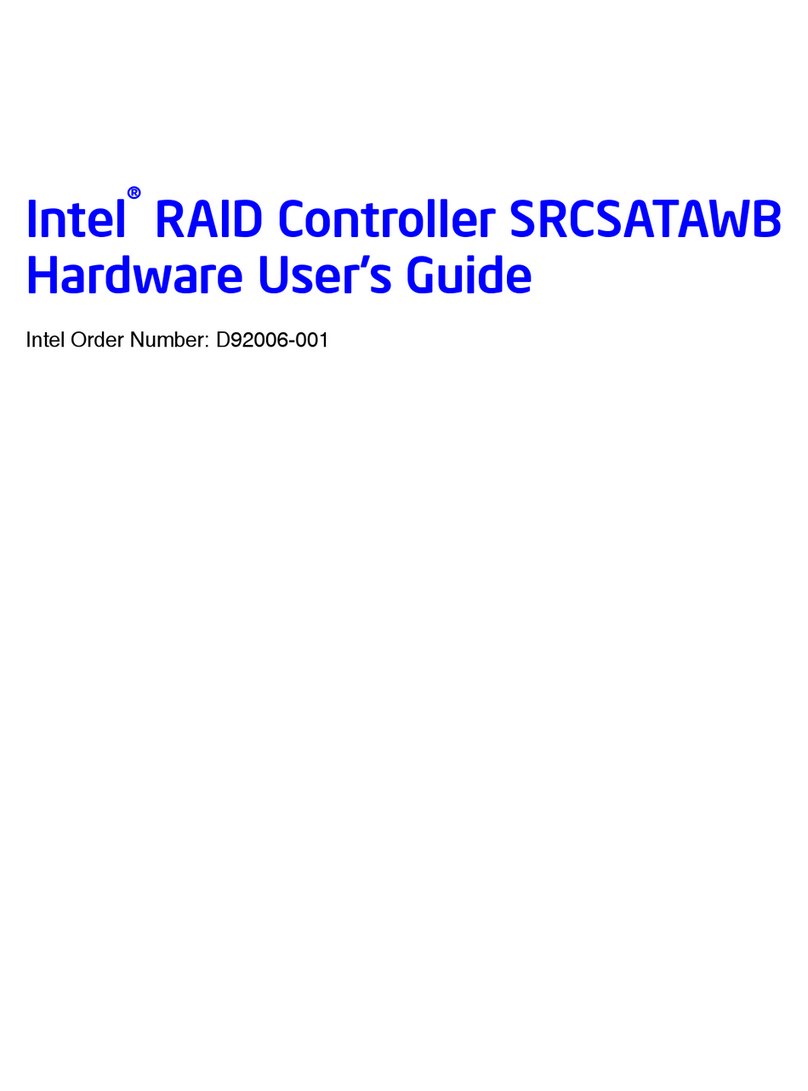
Intel
Intel SRCSATAWB - RAID Controller Hardware user's guide
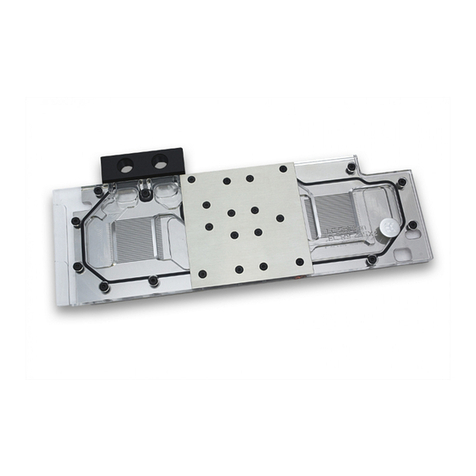
ekwb
ekwb EK-FC R9-295X2 INSTALLATION AND MOUNTING MANUAL

National Instruments
National Instruments NI PXIe-8130 user manual
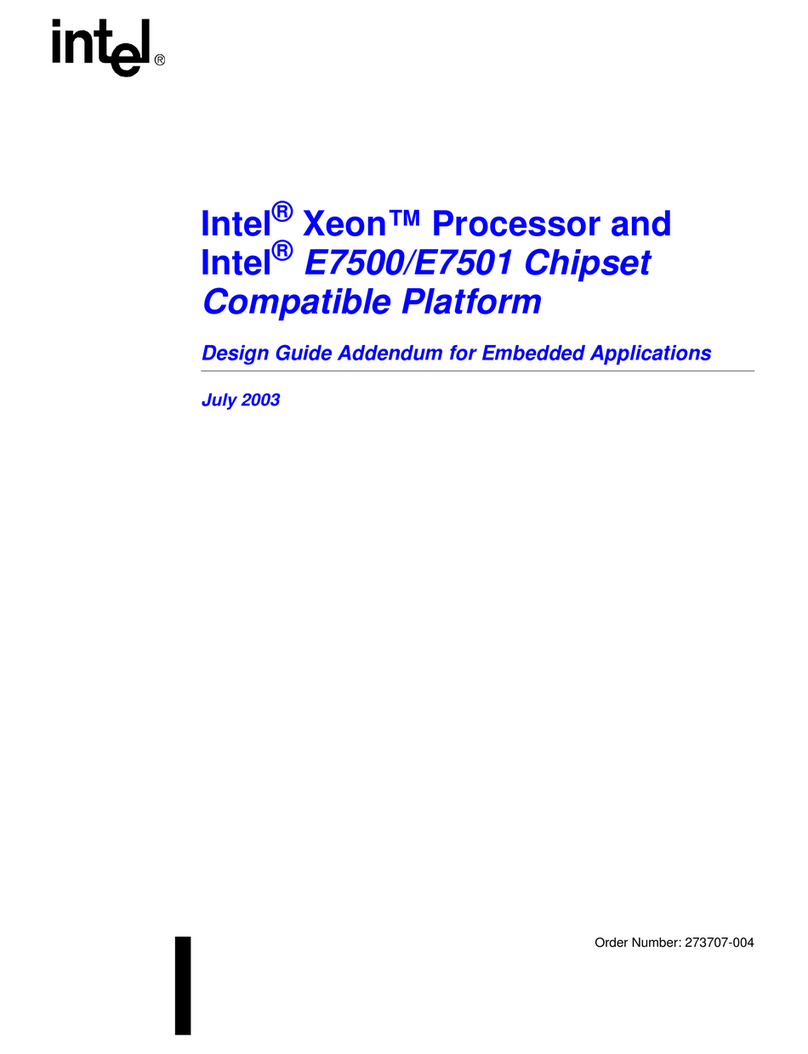
Intel
Intel Xeon Design guide
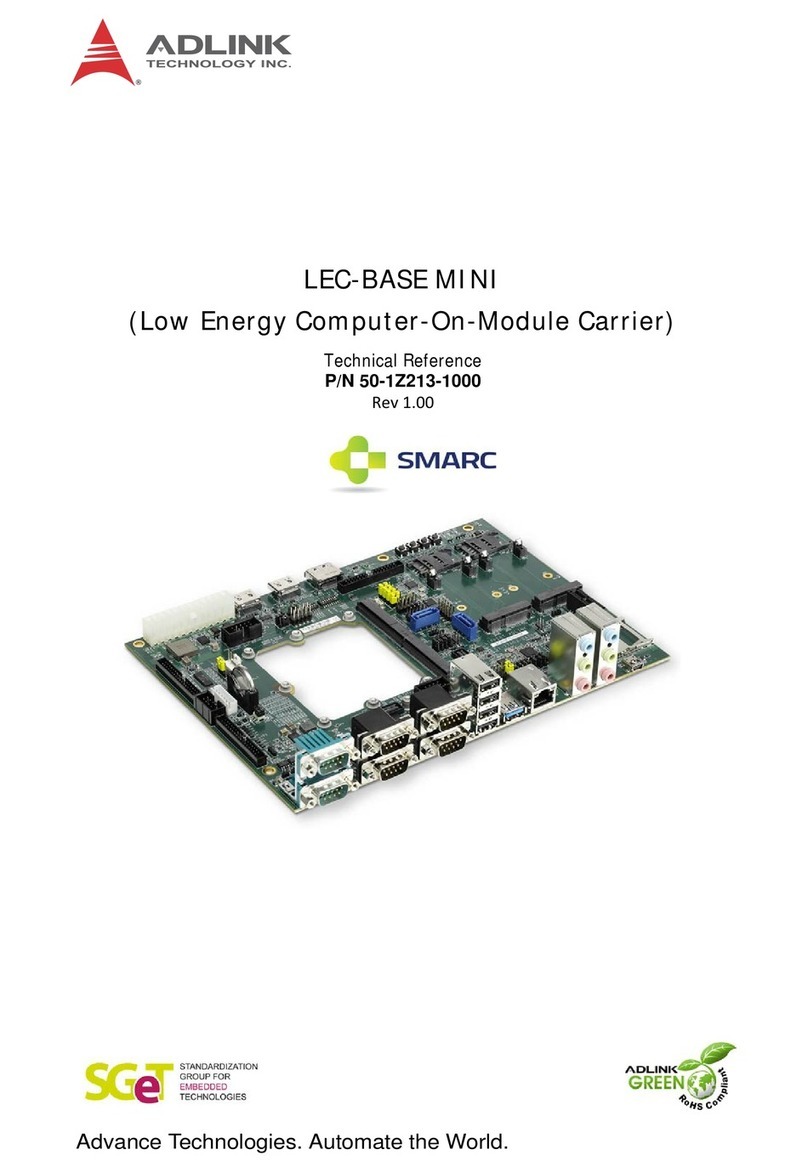
ADLINK Technology
ADLINK Technology LEC-BASE MINI Technical reference
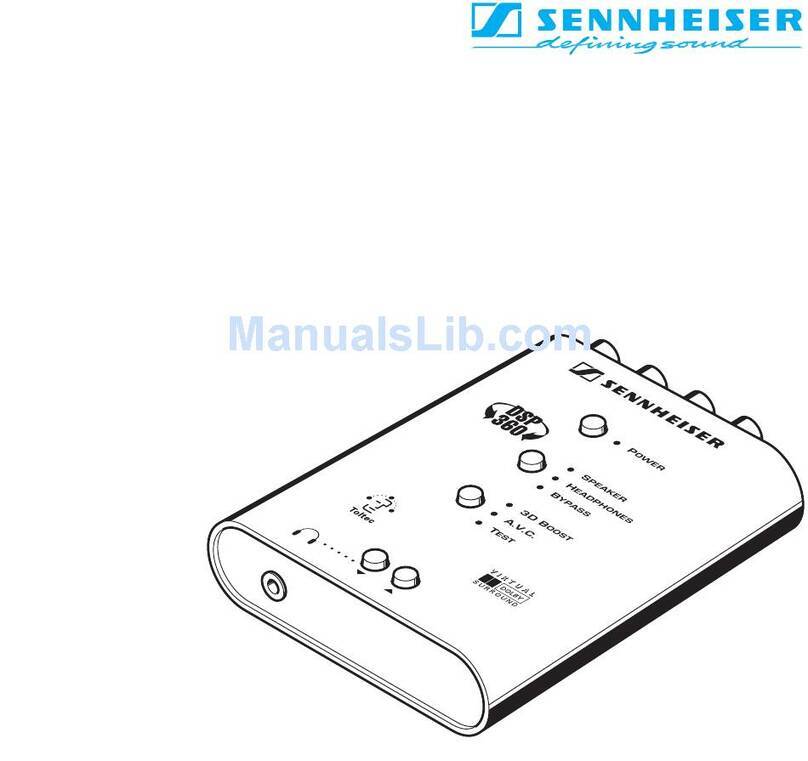
Sennheiser
Sennheiser DSP 360 - SHORT Instructions for use

